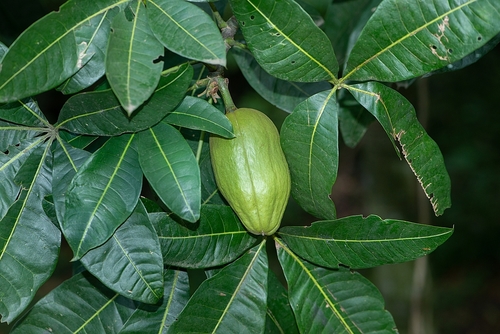Pachira glabra

|
|
Pachira glabra Common Names: Guinea Peanut, Lucky Tree, Guiana
Chestnut, Saba Nut, Money Tree Scientific
Classification Kingdom: Plantae Clade: Tracheophytes Clade: Angiosperms Clade: Eudicots Order: Malvales Family: Malvaceae Genus: Pachira Species: P. glabra Authority: Pasq. Synonyms: Bombacopsis glabra (Pasq.) A.Robyns, Pachira macrocarpa (Schltdl. & Cham.) Walp., Carolinea macrocarpa Schltdl. & Cham. Morphological Description Pachira glabra is
an evergreen or semi-deciduous tree in the Malvaceae family, typically growing
4–12 m tall, occasionally reaching 18 m in the wild: · Trunk: Smooth, greyish-brown, 20–30 cm in diameter, often swollen
at the base (Fern, 2024). · Leaves: Palmate, with 5–9 lanceolate leaflets, 15–27 cm long, 5–10
cm wide, glossy green (Barwick, 2004). · Flowers: Large, 10–15 cm long, white to pinkish, fragrant, with
numerous red-tipped stamens, nocturnal (Burkill, 1997). · Fruit: Semi-woody capsule, 10–20 cm long, green to brown, splitting
to reveal 10–25 edible seeds (Fern, 2024). Distribution and Habitat Pachira glabra is
native to eastern Brazil and extends to Central America: · Range: Eastern Brazil (e.g., Maranhão), Panama, Costa Rica;
cultivated in West Africa, Southeast Asia, and the Caribbean (Fern, 2024). · Habitat: Riverbanks, wetlands, floodplains; tolerates clay to sandy
soils, 25–35°C, full sun to partial shade, drought, and flooding (Burkill,
1997). Ethnopharmacology Pachira glabra (Malabar
chestnut) possesses several medicinal properties due to its rich content of
flavonoids, alkaloids, saponins, tannins, and essential oils(Gamal El-Din et
al., 2020):. It has been traditionally used for its anti-inflammatory,
analgesic, antimicrobial, antioxidant, and wound-healing properties. Some
studies suggest that its extracts may help in reducing pain, swelling, and
oxidative stress, making it useful in managing inflammatory conditions and
snakebites in folk medicine. Additionally, Pachira
glabra has been reported to exhibit antimicrobial activity, making it
potentially beneficial for treating skin infections and gastrointestinal
disorders. The plant's bioactive compounds also contribute to its antioxidant
effects, which may protect against cellular damage and aging-related diseases.
While traditional knowledge supports its medicinal use, further scientific
studies are necessary to fully validate its therapeutic potential and explore
its applications in modern medicine. · Antivenom: Bark extracts in Brazil treat Bothrops snakebites. · Antimicrobial: Leaf oil in Nigeria fights infections. Lawal et al. (2014)
found trans-phytol (28.72%) active against Escherichia coli (MIC 0.5 mg/mL). · Gastroprotective: Leaves in Egypt for ulcers. Gamal El-Din
et al. (2020) showed leaf extract (400 mg/kg) reduced ethanol-induced ulcers in
rats by 70%. · Anti-inflammatory: Bark in Central America for swelling.
Burkill (1997) documents its traditional use. · Nutritional: Seeds eaten in Brazil for energy. Rodrigues, et al. (2021) report 53.9% lipids and
16.9% protein content. ⚠ Toxicity Profile: Unripe seeds may cause mild digestive upset due
to tannins. High doses of leaf extract (>1000 mg/kg) showed liver enzyme
elevation in rats after 30 days (Gamal El-Din et al., 2020). Additional Uses · Culinary: Roasted seeds taste like peanuts; young leaves and flowers
cooked as vegetables (Fern, 2024). · Ornamental: Grown as "money tree" with braided trunks,
symbolizing prosperity in East Asia (Barwick, 2004). · Industrial: Seed oil used in soaps and cosmetics in Brazil (Rodrigues,
et al., 2021). References
External Links More Pictures |
|
| Compounds of Pachira glabra |
|
| References |